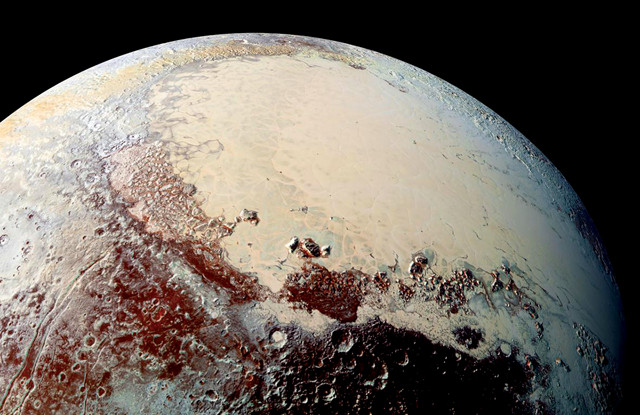
by Rachel Crowell Monday, October 17, 2016

Sputnik Planum, a 900,000-square-kilometer ice-filled basin on Pluto, is home to peculiar polygonal domes. New research indicates that the polygons were formed by convection, rather than thermal contraction, within thick layers of nitrogen ice. Credit: NASA/JHUAPL/SwRI.
Among Pluto’s peculiar surface features, many of which were first seen just last year when NASA’s New Horizons spacecraft zipped by the dwarf planet, are polygon-shaped rises covering parts of a large equatorial basin known as Sputnik Planum. The basin is known to be filled mainly with ices of nitrogen, methane and carbon monoxide, but the origin of the polygons has been debated. In a pair of new studies published in Nature, two teams of researchers now attribute the distinctive shapes to convection within underlying layers of frozen nitrogen.
Previously, scientists suggested that either convection or thermal contraction could have created Pluto’s polygons, each of which is about 10 to 40 kilometers across and tens of meters tall. But, the teams behind the new studies concluded that contraction was an unlikely explanation for the polygonal terrain in Sputnik Planum.
William McKinnon, a planetary geophysicist at Washington University in St. Louis, and his colleagues investigated how heat flow through Pluto’s subsurface should shape its surface, studying existing data on the deformation behavior of nitrogen and methane ices, along with imagery and compositional information about Pluto’s ices from New Horizons. The researchers concluded that, given estimated heat-flow conditions on present-day Pluto determined in this and earlier work, convection should occur in layers of frozen nitrogen thicker than 1 kilometer.
Further, the imagery allowed the team to document the lateral extents of the polygons and calculate their relative heights — dimensions determined by the depth of underlying convection cells, with deeper cells producing larger surface features. The sizes of the polygons in Sputnik Planum suggest that the convective overturning happening there occurs in layers of nitrogen ice that are several kilometers thick, the researchers noted. “This is the first example in the solar system of thermal convection of solid material in which the convection is exposed at the surface, as opposed to hiding below a surface lithosphere or plate,” McKinnon says.
The team also estimated that the surface of the convecting part of Sputnik Planum renews every 500,000 years or so, based on calculations indicating that Sputnik Planum’s surface ice moves horizontally at a velocity of a few centimeters per year. McKinnon says he thinks that similar convective surface renewal may be present on other bodies in the Kuiper Belt, the disk-shaped region beyond Neptune’s orbit that is thought to contain trillions of icy comets and asteroids.
In the second paper, Alexander Trowbridge, a graduate student studying planetary science at Purdue University, and his colleagues used their own model of Sputnik Planum’s nitrogen ice and also found that the polygons are most likely created by convection. They found that brittle deformation, a condition that’s usually necessary for thermal contraction in an ice layer, is unlikely to occur at Sputnik Planum because this type of deformation requires that stresses in the ice build quickly, which does not occur in the ice of Sputnik Planum. Also, the morphology and size of the polygons are inconsistent with how they would look if they were formed by contraction, Trowbridge says, noting that such polygons, if formed by contraction, would be smaller.
Scott King, a geophysicist at Virginia Tech who was not involved with either of the studies, calls the new findings “exciting,” and says it’s interesting that “most, if not all, of the nitrogen at the surface [of Pluto] is concentrated in this deep basin. … What makes the result surprising is that there is a region with a large enough thickness of nitrogen that it can convect.”
Before the New Horizons flyby, Pluto was thought to be mostly quiet in terms of geologic activity, Trowbridge says. “Our paper, as well as the one by Bill McKinnon’s group … has shown that this is not the case.” The presence of convecting nitrogen in Sputnik Planum “not only changes what we thought of Pluto,” he says, “but the criteria for a geologically active body as well.”
© 2008-2021. All rights reserved. Any copying, redistribution or retransmission of any of the contents of this service without the expressed written permission of the American Geosciences Institute is expressly prohibited. Click here for all copyright requests.